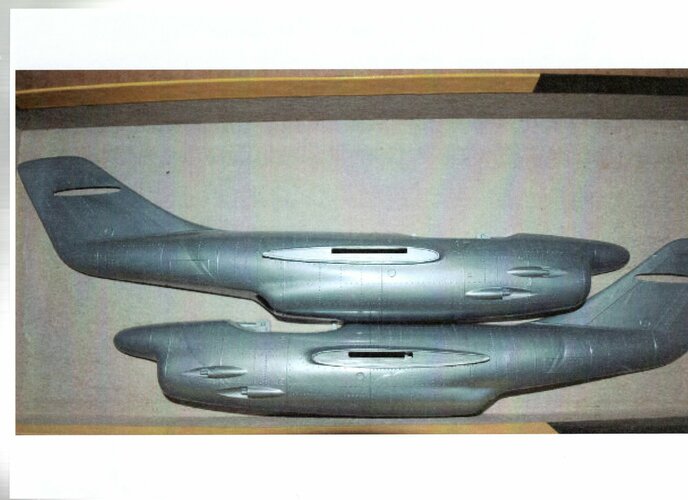- Russian Fakes
At the beginning of the Cold War the Soviets adopted a policy of maximum secrecy to hide their technical inferiority. In 1947 the U.S. intelligence organization lacked the resources to penetrate the Soviet curtain of secrecy to collect information concerning military bases or atomic research sites far from Moscow.
According to the Air material Command's Intelligence Department, the 95 per cent of the information available on the new types of Soviet airplanes had been obtained during the annual Soviet Air Day Show.
During the Summer Aviation Day display at Thusino Airfield on 3 August 1947, the Soviets revealed the existence of six new types of jet fighters, including the Lavochkin La-160 prototype fitted with swept wings. The variety of unknown models caused some confusion among the journalists attending the event and it was the origin of a lucrative traffic of tricky photographs coming from East Germany that remained active until the early sixties.
The introduction of the MiG-15 in North Korea in August of 1950 was a bad surprise for the Western World and aviation specialists had the temptation to speculate what could be the next Soviet fighter.
Within this concept, in which the mystery and the lack of information about what happened at the other side of the
Iron Curtain favored the curiosity of the western public.
All the airplanes and popular science magazines, as well as Jane’s military hardware books, carried stories of rumored Russian fighter that would replace the MiG-15.
Most of these rumors were related to disinformation tactics employed by both sides and the legend was perpetuated until the early sixties.
Certain information on the MiG I-320 coming from East Germany was filtered to the western press in 1951 and it was interpreted as the description of an advanced version of the well-known MiG-9 with side-by-side axial-flow turbojets, swept wing and tail surfaces.
In December 1951
Flying magazine published an illustration and a three-view drawing of the “Super-MiG/MiG-17” with a landing gear like that of the MiG-15, radar snout and four belly mounted cannon.
According to
Flying the new fighter had been identified by USAF in Korea as "flat" MiG.
On February 16, 1953,
American Aviation Magazine published an illustration coming from Associated Press Wirephoto depicting an operational "MiG-17" with No. 157.
On April 13, 1953,
LIFE magazine publishes the schematic cutaway of a Soviet jet fighter that defines as “latest MiG model 17 with double jets, all weather radar, 50,000 ft. ceiling, 6,000 ft/min climb rate, 650 mph top speed, 15,000 lb. take-off weight and four belly mounted cannon”.
According to
LIFE the “MiG-17” has not yet been used in Korea.
In June 1953, the
Air Trails magazine published an article by James L. Pech entitled “Inside Story of the MiG-19” that included a three views drawing based on the one published by
Flying, an illustration depicting an operational aircraft with the number 107 and a detailed cutaway.
According to
Air Trails, the new Soviet fighter had been revealed in Tushino Air Show in summer of 1952 and was sighted in Korea in October.
The same information was published by Italian magazines
Cielo (December 1953) and
L’Ala D’Italia (April-May 1954).
The
Air Trails article was widely circulated among modelers and aircraft enthusiast, prompting the model maker
Paul Lindberg to release in 1954 the1/48 scale plastic kit Nº R521-79 called “Russian MiG-19”, engineered from drawings in
Air Trails. In the 1955 and 1959 editions the denomination in the box art changed to “Russian Jet Fighter”.
This “Soviet fighter” became so popular that it was used in the cover color of
Men in Action (September 1955).
According to an article by Jean-Claude Mermet published in
Aéro Journal Nº 9 (October-November 1999), a three views black silhouettes of the "MiG-19" was included in
L'Armee de L'Air aircraft identification chart of 1955.
In 1957 the Japanese manufacturer of model kits Bachmann launched the 1/200 scale version of the
Air Trails fighter.
Ironically in 1963 the Soviet State Trading Company bought the
Lindberg mold to produce the “MiG-19” kit in the Moscow City Council of National Economy-Factory of Metal and Plastic Toys.
According to an article by W.R. Matthews published in
Flying Review (March 1964), for some extraordinary reason, possibly connected with the activities of Russian counterintelligence any reference to MiG OKB was omitted from the little leaflet which accompanies the kit. The fact that most of the information leaked to the West belonged to failed Soviet projects seems to support this theory.












